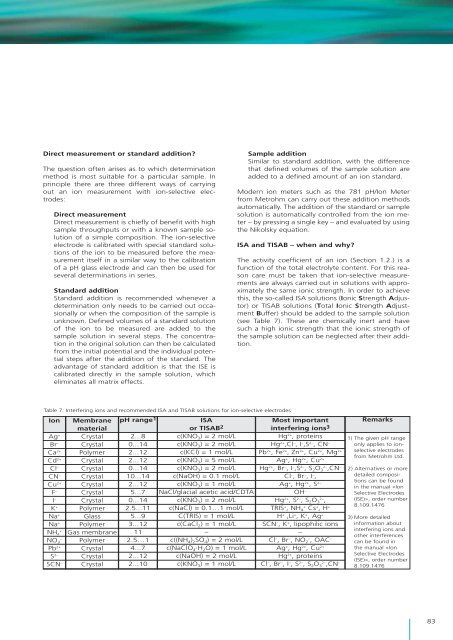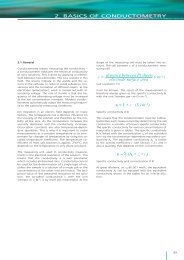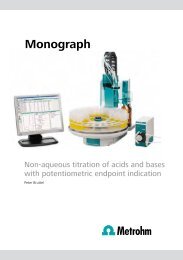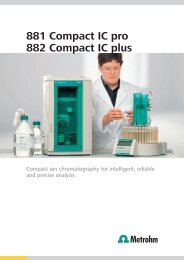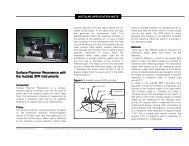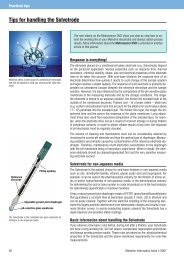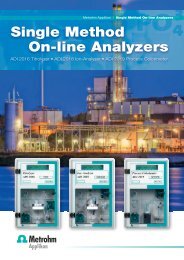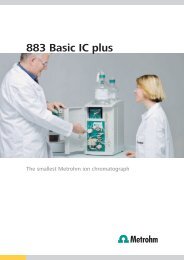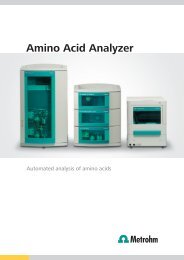What is the theoretical background of potentiometry? - Metrohm
What is the theoretical background of potentiometry? - Metrohm
What is the theoretical background of potentiometry? - Metrohm
Create successful ePaper yourself
Turn your PDF publications into a flip-book with our unique Google optimized e-Paper software.
Direct measurement or standard addition?The question <strong>of</strong>ten ar<strong>is</strong>es as to which determinationmethod <strong>is</strong> most suitable for a particular sample. Inprinciple <strong>the</strong>re are three different ways <strong>of</strong> carryingout an ion measurement with ion-selective electrodes:Direct measurementDirect measurement <strong>is</strong> chiefly <strong>of</strong> benefit with highsample throughputs or with a known sample solution<strong>of</strong> a simple composition. The ion-selectiveelectrode <strong>is</strong> calibrated with special standard solutions<strong>of</strong> <strong>the</strong> ion to be measured before <strong>the</strong> measurementitself in a similar way to <strong>the</strong> calibration<strong>of</strong> a pH glass electrode and can <strong>the</strong>n be used forseveral determinations in series.Standard additionStandard addition <strong>is</strong> recommended whenever adetermination only needs to be carried out occasionallyor when <strong>the</strong> composition <strong>of</strong> <strong>the</strong> sample <strong>is</strong>unknown. Defined volumes <strong>of</strong> a standard solution<strong>of</strong> <strong>the</strong> ion to be measured are added to <strong>the</strong>sample solution in several steps. The concentrationin <strong>the</strong> original solution can <strong>the</strong>n be calculatedfrom <strong>the</strong> initial potential and <strong>the</strong> individual potentialsteps after <strong>the</strong> addition <strong>of</strong> <strong>the</strong> standard. Theadvantage <strong>of</strong> standard addition <strong>is</strong> that <strong>the</strong> ISE <strong>is</strong>calibrated directly in <strong>the</strong> sample solution, whicheliminates all matrix effects.Sample additionSimilar to standard addition, with <strong>the</strong> differencethat defined volumes <strong>of</strong> <strong>the</strong> sample solution areadded to a defined amount <strong>of</strong> an ion standard.Modern ion meters such as <strong>the</strong> 781 pH/Ion Meterfrom <strong>Metrohm</strong> can carry out <strong>the</strong>se addition methodsautomatically. The addition <strong>of</strong> <strong>the</strong> standard or samplesolution <strong>is</strong> automatically controlled from <strong>the</strong> ion meter– by pressing a single key – and evaluated by using<strong>the</strong> Nikolsky equation.ISA and TISAB – when and why?The activity coefficient <strong>of</strong> an ion (Section 1.2.) <strong>is</strong> afunction <strong>of</strong> <strong>the</strong> total electrolyte content. For th<strong>is</strong> reasoncare must be taken that ion-selective measurementsare always carried out in solutions with approximately<strong>the</strong> same ionic strength. In order to achieveth<strong>is</strong>, <strong>the</strong> so-called ISA solutions (Ionic Strength Adjustor)or TISAB solutions (Total Ionic Strength AdjustmentBuffer) should be added to <strong>the</strong> sample solution(see Table 7). These are chemically inert and havesuch a high ionic strength that <strong>the</strong> ionic strength <strong>of</strong><strong>the</strong> sample solution can be neglected after <strong>the</strong>ir addition.Table 7: Interfering ions and recommended ISA and TISAB solutions for ion-selective electrodesIonAg +Br –Ca 2+Cd 2+Cl –CN –Cu 2+F –I –K +Na +Na ++NH 4–NO 3Pb 2+S 2–SCN –MembranematerialCrystalCrystalPolymerCrystalCrystalCrystalCrystalCrystalCrystalPolymerGlassPolymerGas membranePolymerCrystalCrystalCrystalpH range 12...80...142...122...120...1410...142...125...70...142.5...115...93...12112.5…14...72...122...10ISAor TISAB 2c(KNO 3 ) = 2 mol/Lc(KNO 3 ) = 2 mol/Lc(KCl) = 1 mol/Lc(KNO 3 ) = 5 mol/Lc(KNO 3 ) = 2 mol/Lc(NaOH) = 0.1 mol/Lc(KNO 3 ) = 1 mol/LNaCl/glacial acetic acid/CDTAc(KNO 3 ) = 2 mol/Lc(NaCl) = 0.1…1 mol/LC(TRIS) = 1 mol/Lc(CaCl 2 ) = 1 mol/L–c((NH 4 ) 2 SO 4 ) = 2 mol/Lc(NaClO 4·H 2 O) = 1 mol/Lc(NaOH) = 2 mol/Lc(KNO 3 ) = 1 mol/LMost importantinterfering ions 3Hg 2+ , proteinsHg 2+ ,Cl – , I – ,S 2– , CN –Pb 2+ , Fe 2+ , Zn 2+ , Cu 2+ , Mg 2+Ag + , Hg 2+ , Cu 2+Hg 2+ , Br – , I – ,S 2– , S 2 O 32–,CN –Cl – , Br – , I – ,Ag + , Hg 2+ , S 2–OH –Hg 2+ , S 2– , S 2 O 32–,TRIS + , NH 4+ Cs + , H +H + ,Li + , K + , Ag +SCN – , K + , lipophilic ions–Cl – , Br – , NO 2– , OAC –Ag + , Hg 2+ , Cu 2+Hg 2+ , proteinsCl – , Br – , I – , S 2– , S 2 O 32–,CN –Remarks1) The given pH rangeonly applies to ionselectiveelectrodesfrom <strong>Metrohm</strong> Ltd.2) Alternatives or moredetailed compositionscan be foundin <strong>the</strong> manual «IonSelective Electrodes(ISE)», order number8.109.14763) More detailedinformation aboutinterfering ions ando<strong>the</strong>r interferencescan be found in<strong>the</strong> manual «IonSelective Electrodes(ISE)», order number8.109.147683


